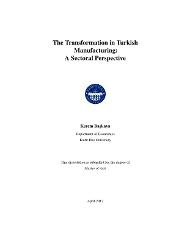| dc.contributor.advisor | Orhangazi, Özgür | en_US |
| dc.contributor.author | Başkaya, Kerem | |
| dc.date.accessioned | 2019-07-12T08:35:39Z | en_US |
| dc.date.available | 2019-07-12T08:35:39Z | en_US |
| dc.date.issued | 2017 | en_US |
| dc.identifier.uri | https://hdl.handle.net/20.500.12469/1921 | |
| dc.description.abstract | In this dissertation, I try to answer the following questions: What are the constants for the manufacturing sector of Turkey in the last decade? What are the indicators that are changed within the manufacturing sector? To answer these questions, I use Annual Industry and Service Statistics dataset years from 2003 to 2014. I do exploratory and descriptive statistical work to analyze the structure of manufacturing sector. I do also use Pavitt Taxonomy, a new methodology for Turkish manufacturing sector, to categorize economic activity. After that, we decomposed the labor productivity into two: the intra-industry productivity and its structural components. My analysis showed that there is no significant change in the structure of Turkish manufacturing sector. The share of low-tech and high-tech sectors were decreased while the share of medium-low-tech was slightly increased according to main indicators such as value added, share of employment and investment. Also, science-based sectors were decreased according to the same indicators. Another important finding is that the intra-industry labor productivity growth increased significantly between 2004 and 2014 in the manufacturing sector. Yet, the static-shift effect (the structural change) was negative within the industry during this period. | en_US |
| dc.description.abstract | Bu tezde şu sorulara yanıt bulmaya çalıştık: Son on yılda Türkiye imalat sanayinin sabitleri nelerdir? imalat sanayi içinde tedrici gelişme gösteren değişkenler nelerdir? 2003, 2014 yılları arasındaki dönem için bu sorulara cevap vermek adına Yıllık Sanayi ve Hizmetler mikro veri setinden yararlandık. Bu sorulara yanıt ararken başlıca tanımlayıcı (descriptive) ve keşifsel (exploratory) istatistik kullandık. Buna ek olarak imalat sanayini kategorize ederken Pavitt Taksonomi metodunu uyguladık. Bu sınıflandırma metodu Türkiye imalat sanayinde henüz kullanılmamış bir yöntem olduğundan bu alandaki çalışmalar için bir yenilik teşkil etmektedir. Çalışmada buna ek olarak emek üretkenliğini bileşkenlerine ayırıp emekteki üretkenlik artışlarının/azalışlarının sebeplerini araştırdık. Çalışmamız, imalat sanayi yapısında önemli bir değişim bulamamıştır. Düşük ve yüksek teknolojili sektörler için üretim miktarı, iş payı gibi temel göstergeler düşerken orta-düşük teknolojili sektörler için aynı göstergelerin imalat sanayi içindeki payı küçük bir miktar artmıştır. Aynı şekilde imalat sanayine Pavitt Taksonomi yardımıyla baktığımızda bilimsel üretime dayanan kategoride bu temel göstergelerin imalat sanayi içindeki paylarında düşüşler görülmektedir ç bir diğer önemli bulgusu imalat sanayindeki sektör içi emek verimliliği ciddi yükseliş gösterirken emek verimliliğinin yapısal değişim bileşeninde düşüşler yaşanmıştır. | en_US |
| dc.language.iso | eng | en_US |
| dc.publisher | Kadir Has Üniversitesi | en_US |
| dc.rights | info:eu-repo/semantics/openAccess | en_US |
| dc.subject | Yapısal değişim | en_US |
| dc.subject | Emek verimliligi | en_US |
| dc.subject | Emek verimliliği bileşenleri | en_US |
| dc.subject | Türkiye İmalat Sanayi | en_US |
| dc.subject | Pavitt Taksonomi | en_US |
| dc.subject | Structural change | en_US |
| dc.subject | Reallocation | en_US |
| dc.subject | Labor productivity | en_US |
| dc.subject | Shift-share analysis | en_US |
| dc.subject | Turkish manufacturing | en_US |
| dc.subject | Pavitt Taxonomy | en_US |
| dc.title | The transformation in Turkish manufacturing :a sectoral perspective | en_US |
| dc.type | masterThesis | en_US |
| dc.department | Enstitüler, Lisansüstü Eğitim Enstitüsü | en_US |
| dc.relation.publicationcategory | Tez | en_US |
| dc.identifier.yoktezid | 475961 | en_US |
















